Reverse Engineering of JPA Entities with JBoss Tools Eclipse Plugin.
The tutorial below details how to do reverse engineering of Hibernate/JPA POJO entities from database tables.
The database tables\entities which are used for this tutorial are Course, Department and Student. The way these 3 tables are related are Courses have a many-to-many relationship with Students and Students have a many-to-many relationship with Departments. This means we have 5 tables in all Student, Course, Department, Department_Student and Student_Course. The DDL for these 5 tables is given below...please take note of the foreign key relationships between tables as these will be interpreted as relationships in the reverse generated POJO entities...
Note: The above DDL script is for MySQL database but should work fine for all relational databases. Also, I am using MySQL as the default database for all my tutorials.
Note 2: There are certain pre-requisites for reverse code generation. These are -
Step 1: Open your JPA Project in Eclipse with the MySQL Data Connection. My JPA project is named 'StudentDeptCourseProject' after my three main entities. The contents in your eclipse window should resemble the snapshot below
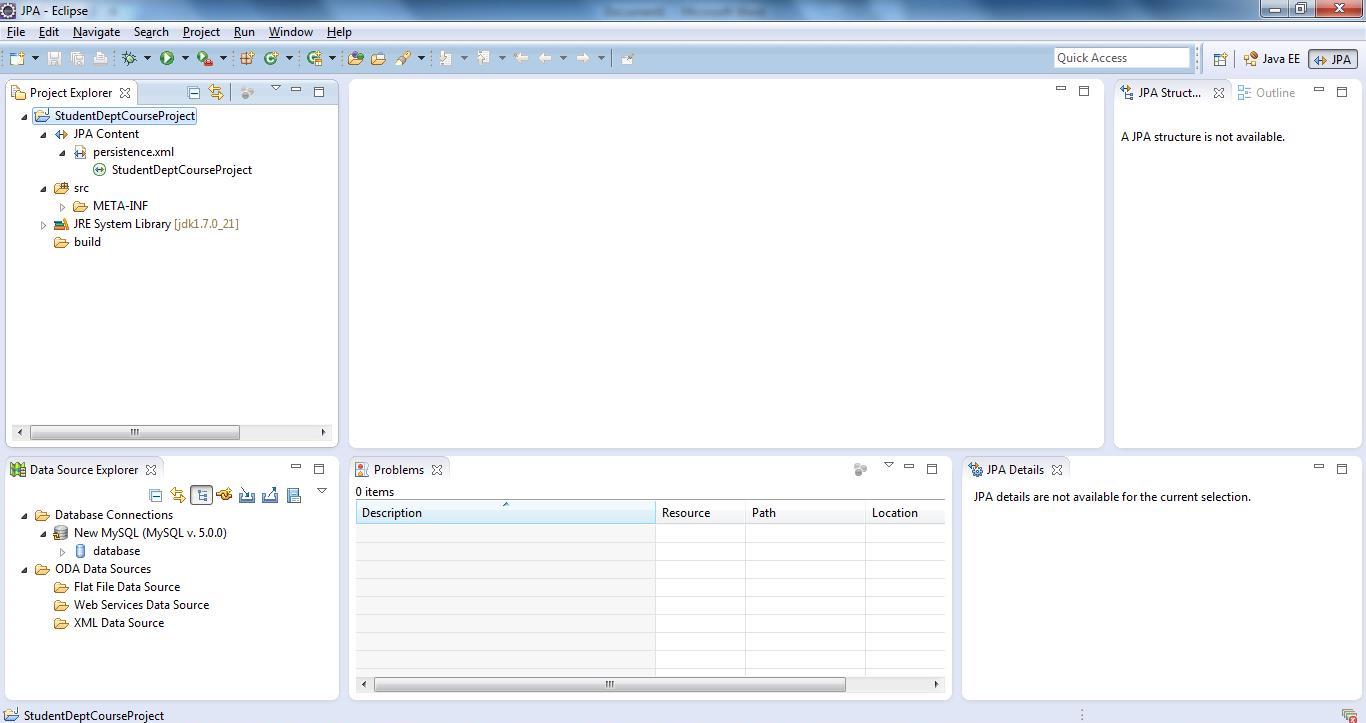 Reverse Code Generation of Hibernate/JPA POJO Entities Step 01
Reverse Code Generation of Hibernate/JPA POJO Entities Step 01
Step 2:Double click on the persistence.xml for StudentDeptCourseProject and view its contents...
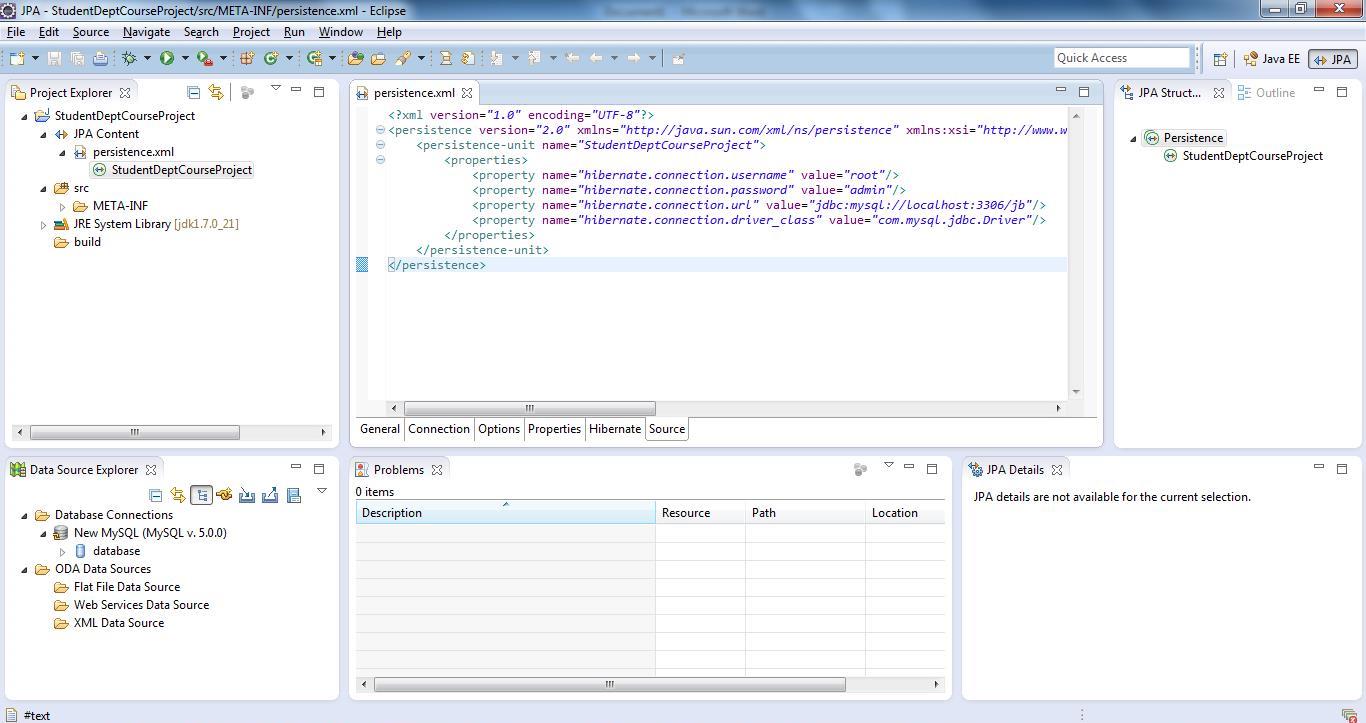 Reverse Code Generation of Hibernate/JPA POJO Entities Step 02
Reverse Code Generation of Hibernate/JPA POJO Entities Step 02
Step 3:For the next step we need to work in the “Hibernate” perspective. Go to Window>Open Perspective>Other… Select “Hibernate” and say “OK”...
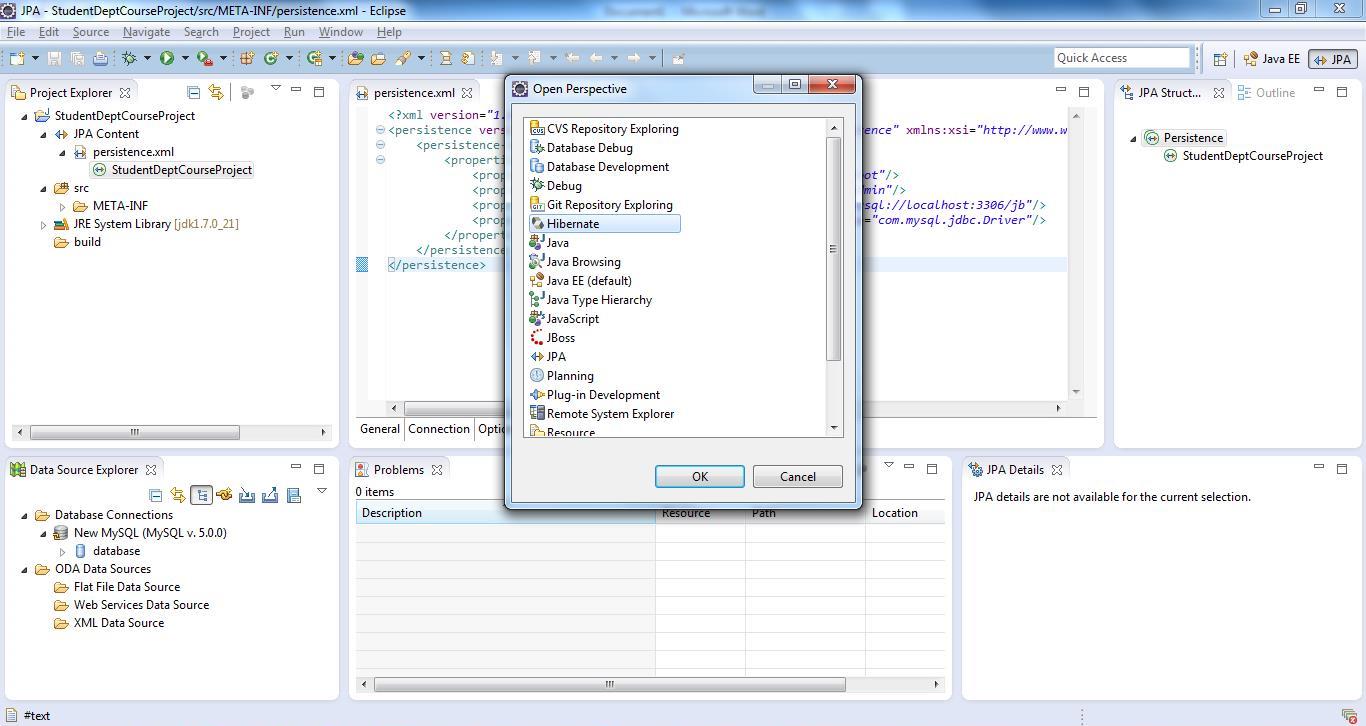 Reverse Code Generation of Hibernate/JPA POJO Entities Step 03
Reverse Code Generation of Hibernate/JPA POJO Entities Step 03
Step 4: The below window gets displayed…
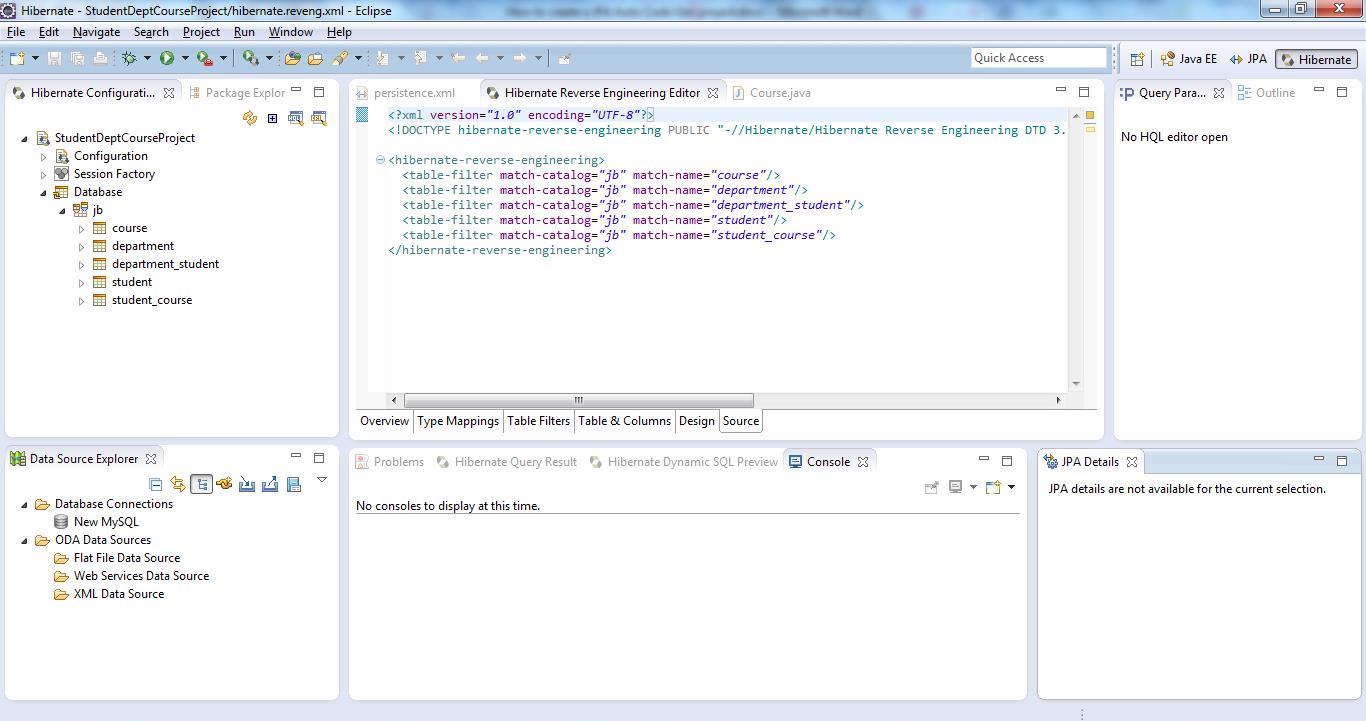 Reverse Code Generation of Hibernate/JPA POJO Entities Step 04
Reverse Code Generation of Hibernate/JPA POJO Entities Step 04
Then click on the "Hibernate Code Generation" icon in the top toolbar ( Arrow A in snapshot below) and then click on the menu item "Hibernate Code Generation Configurations..." (Arrow B)...
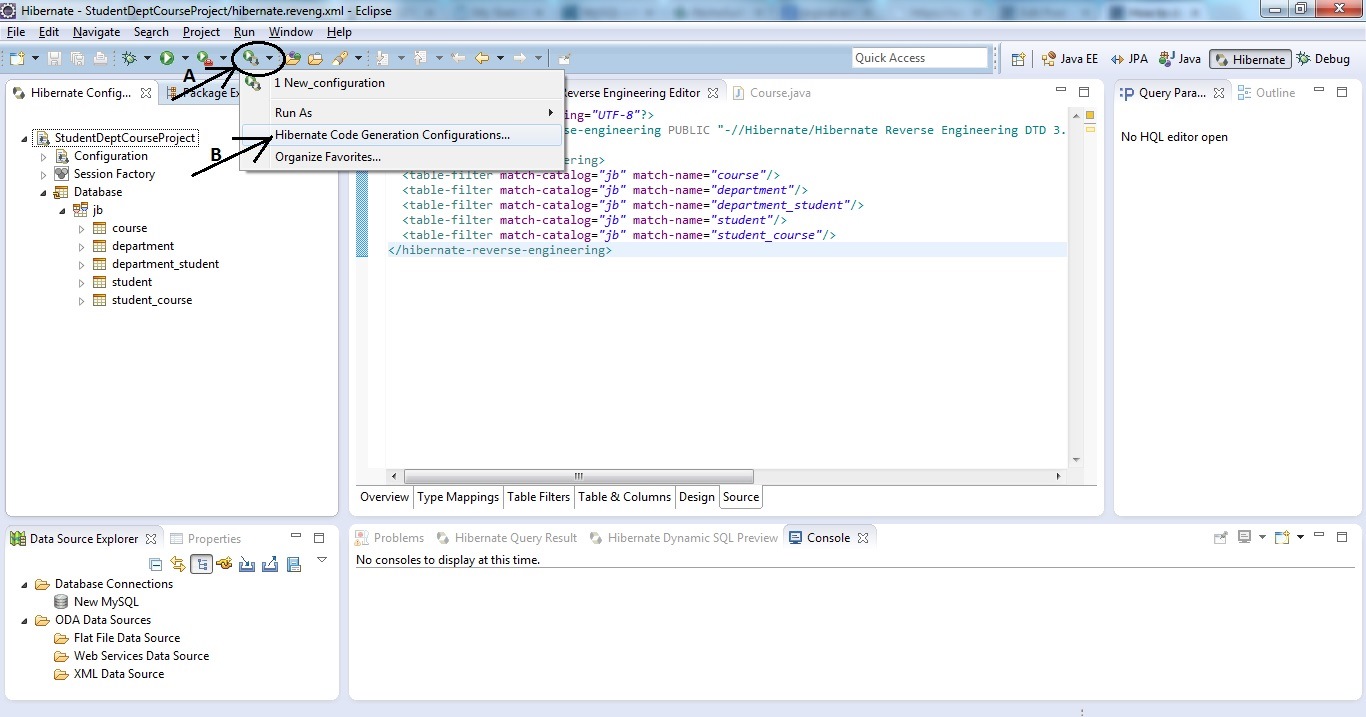 Reverse Code Generation of Hibernate/JPA POJO Entities Step 04 a
Reverse Code Generation of Hibernate/JPA POJO Entities Step 04 a
Step 5: The below dialog box for "Hibernate Code Generation Configurations" gets displayed...
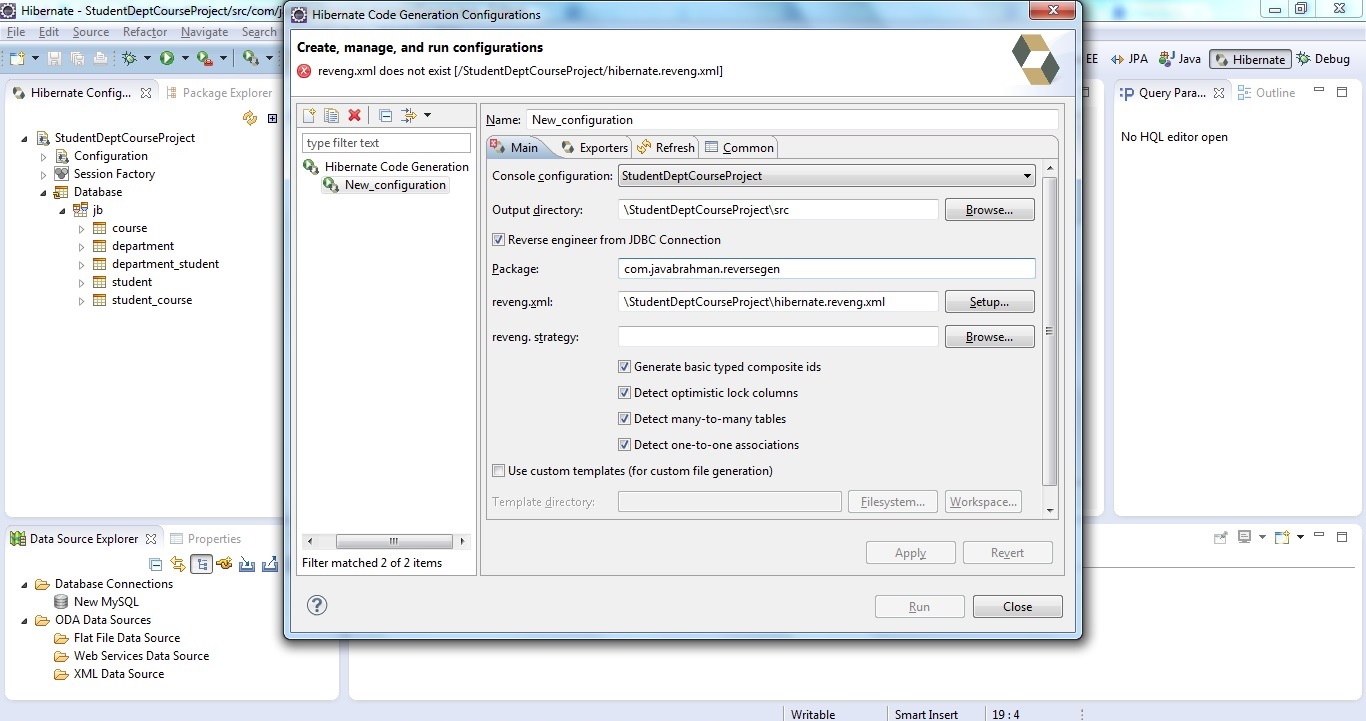 Reverse Code Generation of Hibernate/JPA POJO Entities Step 05
Reverse Code Generation of Hibernate/JPA POJO Entities Step 05
Step 6: In the above displayed dialog box click on “setup” next to reveng.xml and then click on “Create New” button...
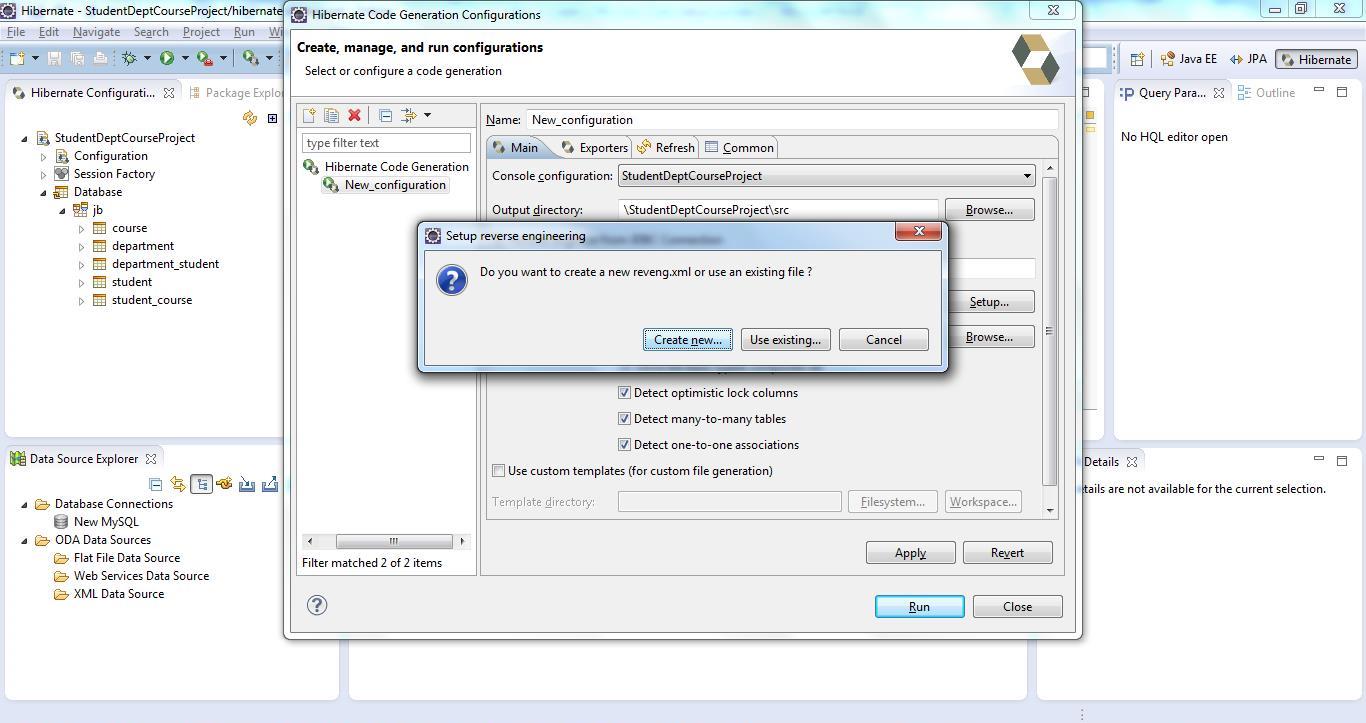 Reverse Code Generation of Hibernate/JPA POJO Entities Step 06
Reverse Code Generation of Hibernate/JPA POJO Entities Step 06
Step 7: Click on the project name StudentDeptCourse project and click “Next”...
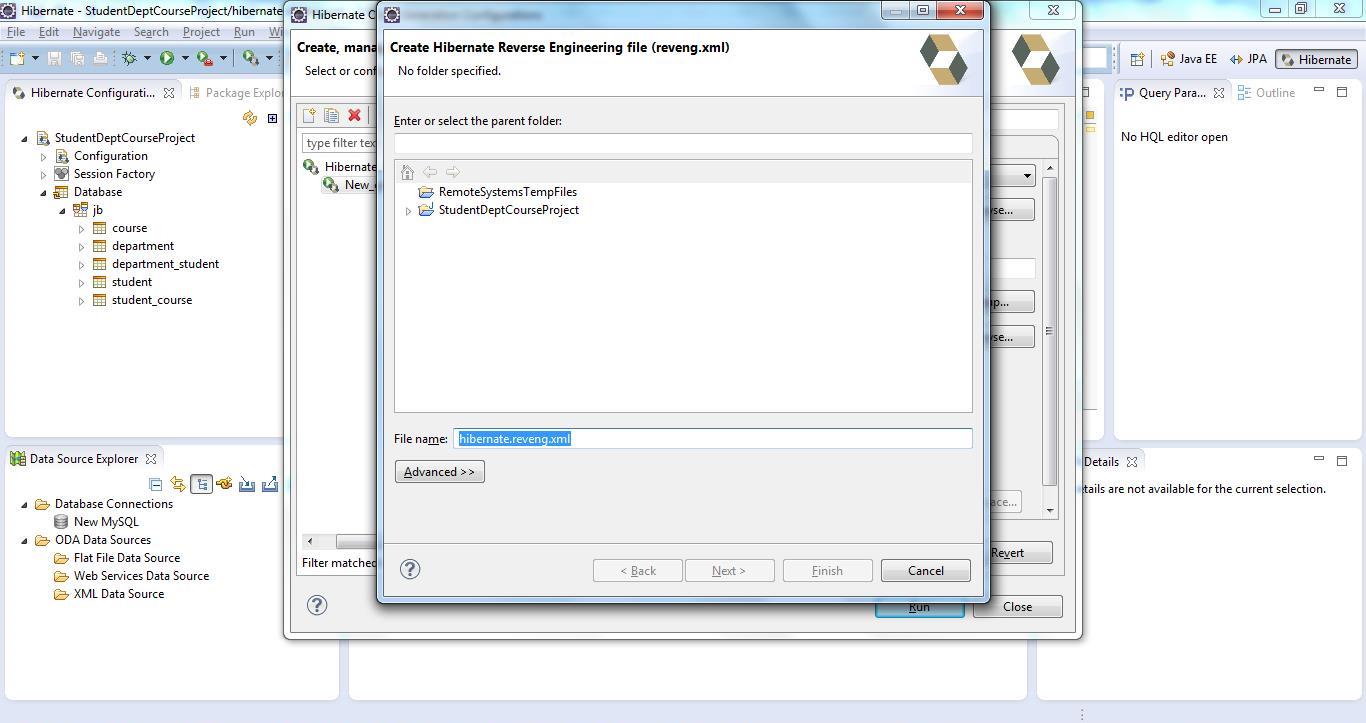 Reverse Code Generation of Hibernate/JPA POJO Entities Step 07
Reverse Code Generation of Hibernate/JPA POJO Entities Step 07
Step 8: In the below window click refresh to show the list of tables in the 'jb' database('jb' is the name of my database in MySQL)...
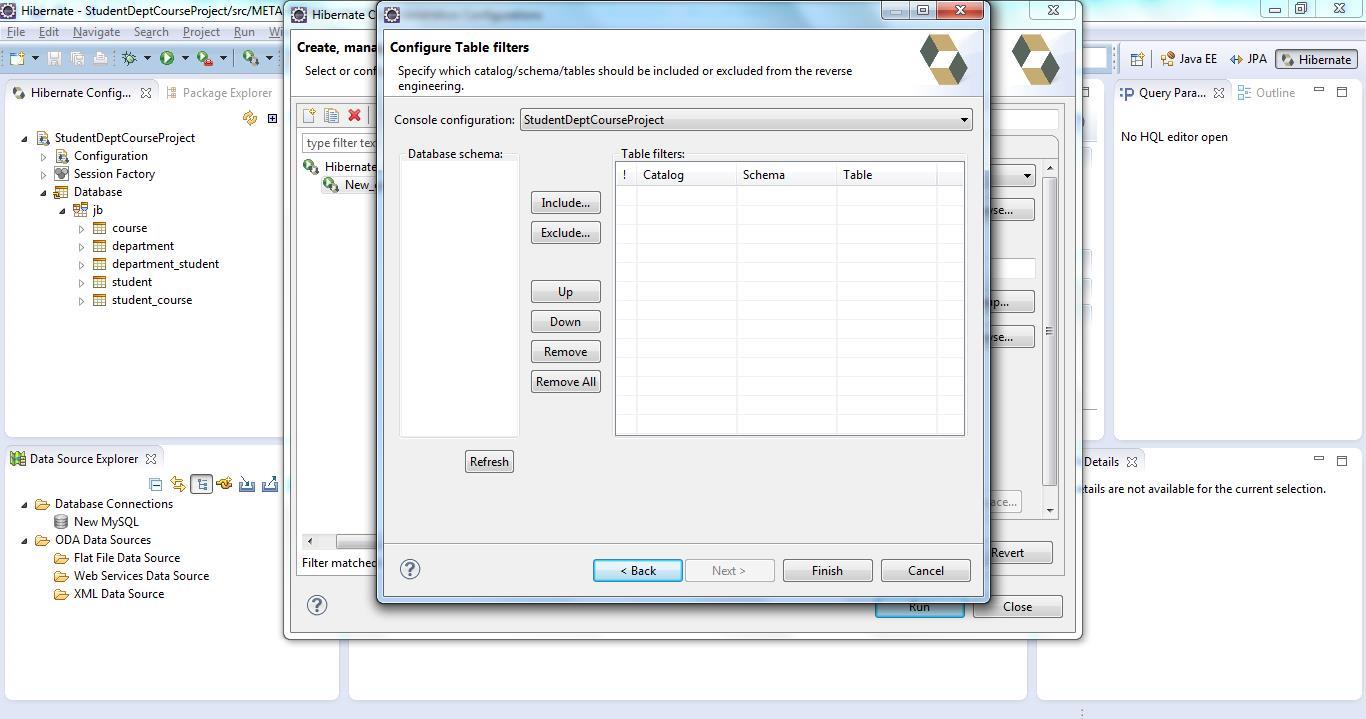 Reverse Code Generation of Hibernate/JPA POJO Entities Step 08
Reverse Code Generation of Hibernate/JPA POJO Entities Step 08
Step 9: Select all the tables and click on “Include”…
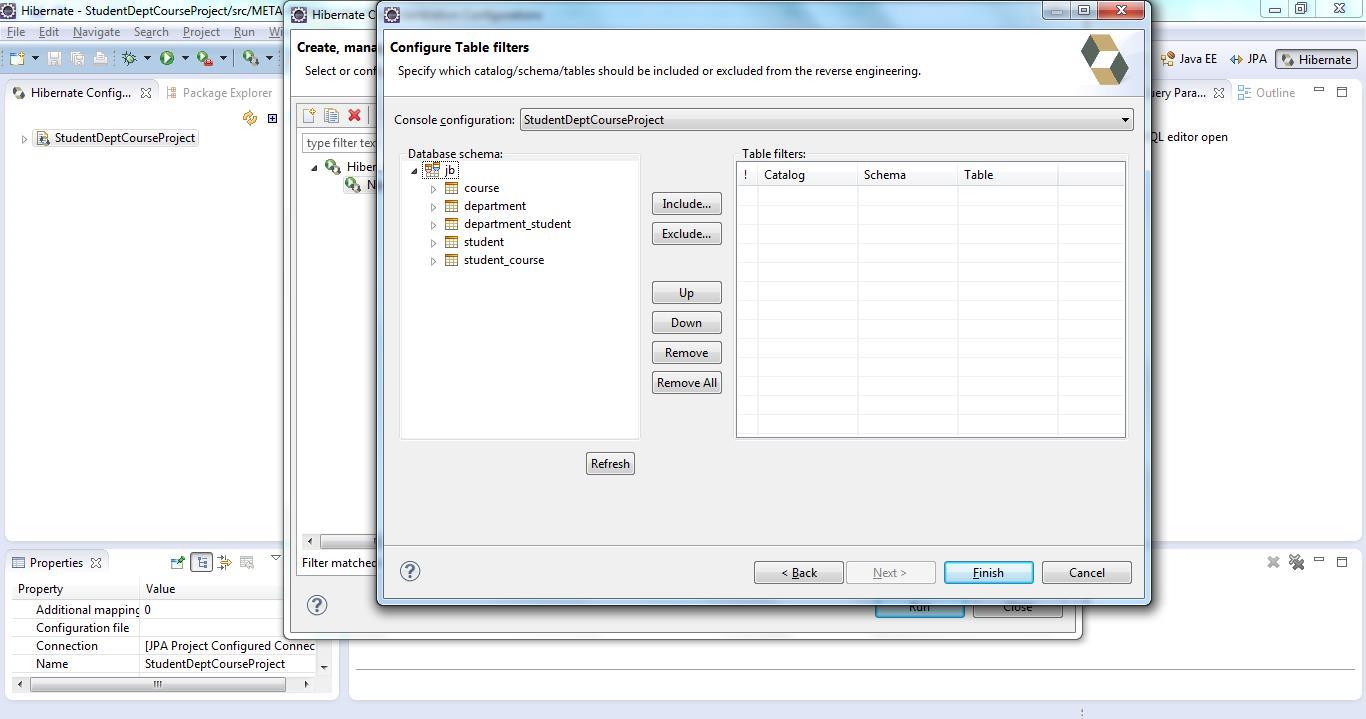 Reverse Code Generation of Hibernate/JPA POJO Entities Step 09
Reverse Code Generation of Hibernate/JPA POJO Entities Step 09
Step 10: Click “Finish” to finish generating “hibernate.reveng.xml”...
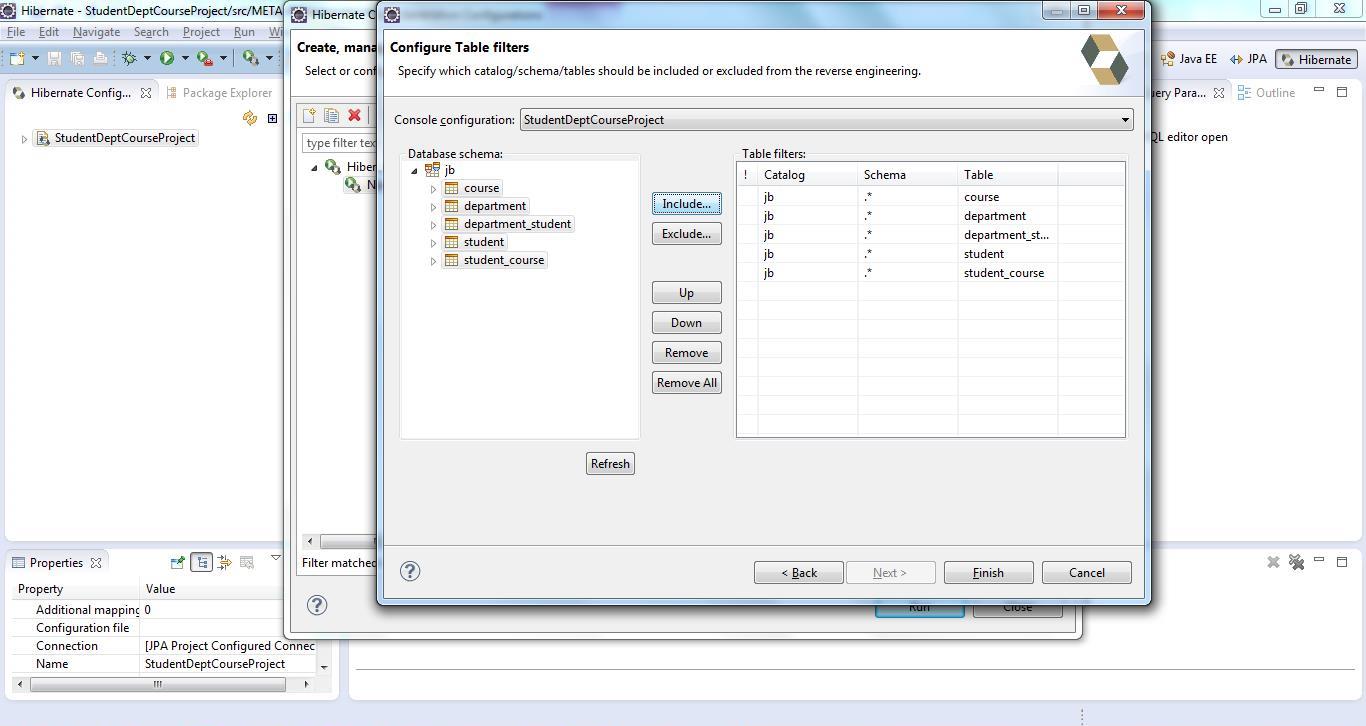 Reverse Code Generation of Hibernate/JPA POJO Entities Step 10
Reverse Code Generation of Hibernate/JPA POJO Entities Step 10
Step 11: This is how the Hibernate Code Generation Configurations window will appear with the entry for reveng.xml in place…
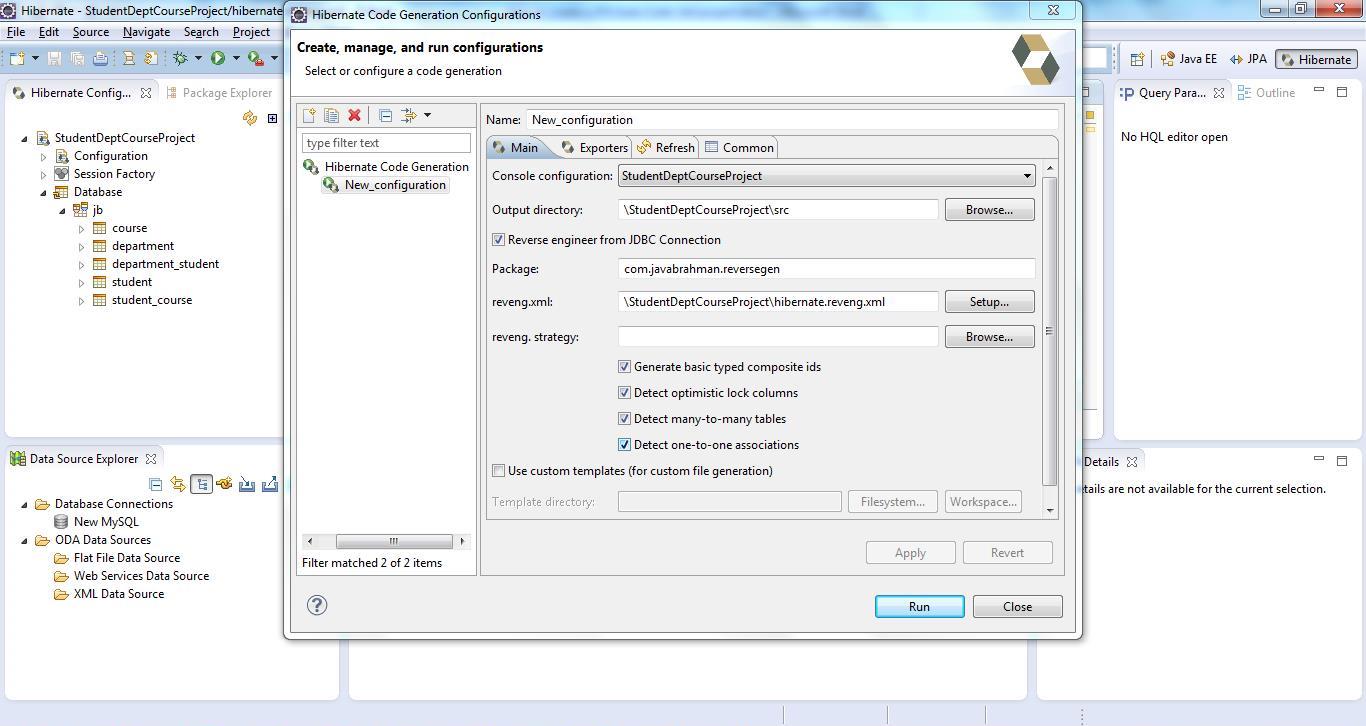 Reverse Code Generation of Hibernate/JPA POJO Entities Step 11
Reverse Code Generation of Hibernate/JPA POJO Entities Step 11
Step 12:Click on the “Exporters” tab to see how it appears…
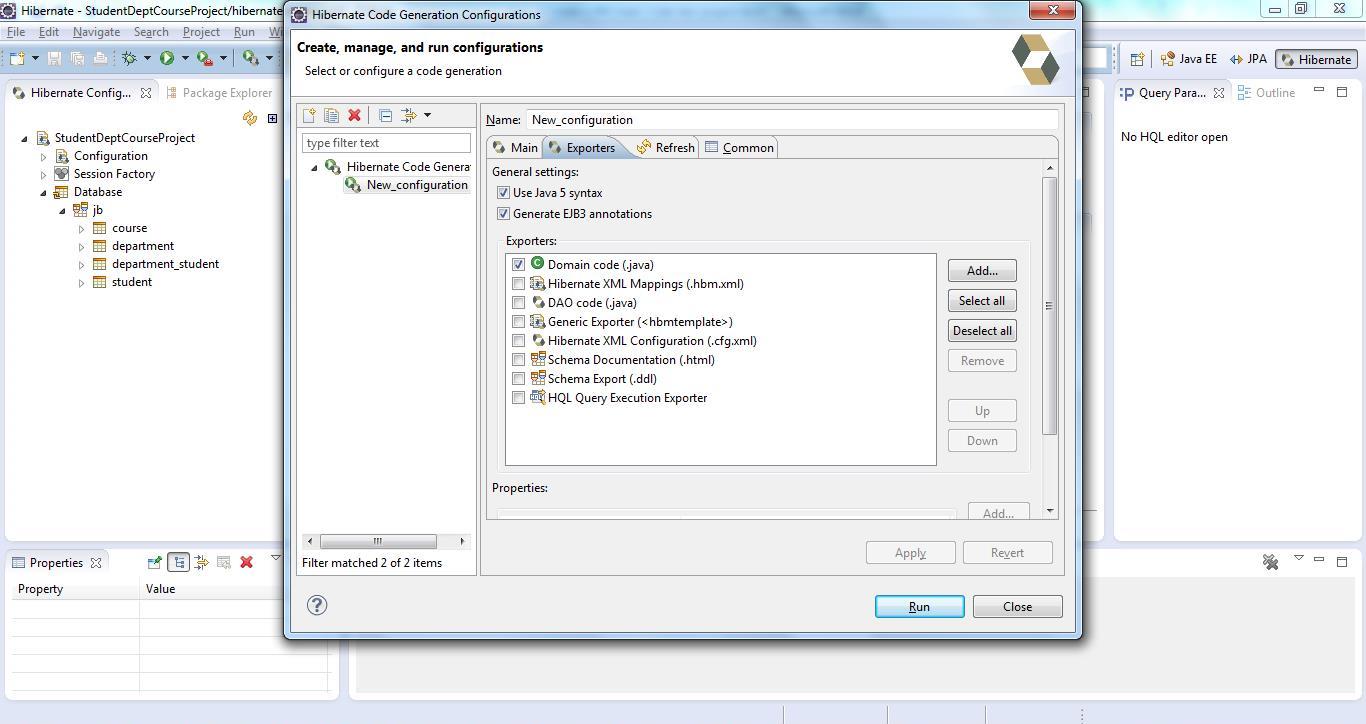 Reverse Code Generation of Hibernate/JPA POJO Entities Step 12
Reverse Code Generation of Hibernate/JPA POJO Entities Step 12
Step 13:The reverse generated JPA POJO entities are present in the package com.javabrahman.reversegen. To view these go to the “Package Explorer” and expand the StudentDeptCourse project…
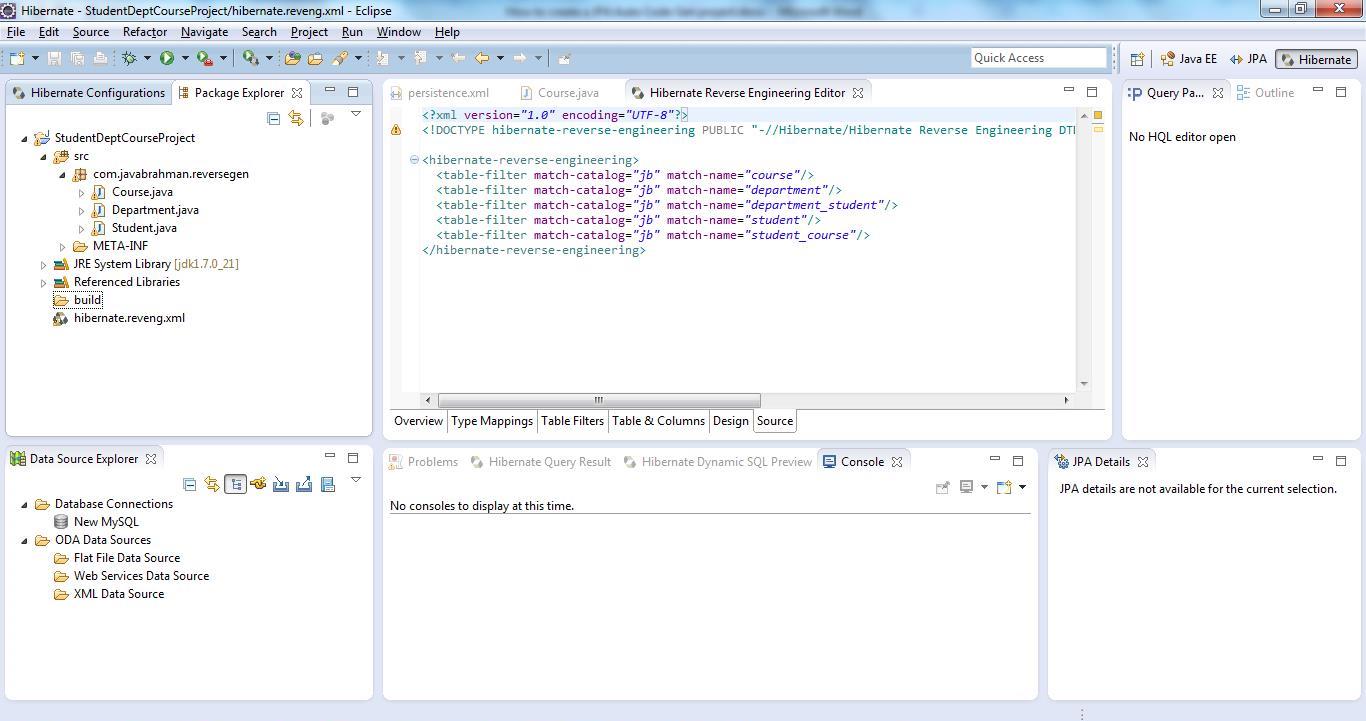 Reverse Code Generation of Hibernate/JPA POJO Entities Step 13
Reverse Code Generation of Hibernate/JPA POJO Entities Step 13
Note that the two many-to-many mapping classes do not have equivalent java entities. This is because these many-to-many entities have been specified as relationship tables in the student entity itself…
Let’s now have a look at the reverse generated Java code…
The database tables\entities which are used for this tutorial are Course, Department and Student. The way these 3 tables are related are Courses have a many-to-many relationship with Students and Students have a many-to-many relationship with Departments. This means we have 5 tables in all Student, Course, Department, Department_Student and Student_Course. The DDL for these 5 tables is given below...please take note of the foreign key relationships between tables as these will be interpreted as relationships in the reverse generated POJO entities...
Scripts for tables - Student, Department & Course
CREATE TABLE `student` (
`STUDENT_ID` INT(11) NOT NULL,
`FIRST_NAME` VARCHAR(255) DEFAULT NULL,
`LAST_NAME` VARCHAR(255) DEFAULT NULL,
`AGE` INT(11) DEFAULT NULL,
`ADDRESS` VARCHAR(255) DEFAULT NULL,
PRIMARY KEY (`STUDENT_ID`)
)
CREATE TABLE `department` (
`DEPT_ID` INT(11) NOT NULL,
`DEPT_NAME` VARCHAR(255) DEFAULT NULL,
PRIMARY KEY (`DEPT_ID`)
)
CREATE TABLE `course` (
`COURSE_ID` INT(11) NOT NULL,
`COURSE_NAME` VARCHAR(255) NOT NULL,
`COURSE_FROM` TIME DEFAULT NULL,
`COURSE_TO` TIME DEFAULT NULL,
PRIMARY KEY (`COURSE_ID`)
)
CREATE TABLE `department_student` (
`Student_id` INT(11) NOT NULL,
`department_id` INT(11) NOT NULL,
PRIMARY KEY (`Student_id`,`department_id`),
KEY `FK_department` (`department_id`),
CONSTRAINT `FK_department` FOREIGN KEY (`department_id`) REFERENCES `department` (`DEPT_ID`),
CONSTRAINT `FK_student` FOREIGN KEY (`Student_id`) REFERENCES `student` (`STUDENT_ID`)
)
CREATE TABLE `student_course` (
`Student_id` INT(11) NOT NULL,
`Course_id` INT(11) NOT NULL,
PRIMARY KEY (`Student_id`,`Course_id`),
KEY `FK_course` (`Course_id`),
CONSTRAINT `FK_student_for_student_course` FOREIGN KEY (`Student_id`) REFERENCES `student` (`STUDENT_ID`),
CONSTRAINT `FK_course` FOREIGN KEY (`Course_id`) REFERENCES `course` (`COURSE_ID`)
)Note 2: There are certain pre-requisites for reverse code generation. These are -
- JBoss Tools eclipse plugin(which includes Hibernate Tools) is needed for the reverse code generation. Please refer to the following tutorial to install JBoss Tools plugin in your Eclipse installation. How to Install JBoss Tools Plugin in Eclipse JunoClick to Read Article
- I am using an Eclipse JPA project for this tutorial created using Eclipse Juno. To know the steps for creating a JPA project from scratch along with a MySQL Data Connection using Eclipse Juno please refer to the following tutorial first Setup a JPA Project with MySQL Data ConnectionClick to Read Article
 Reverse Code Generation of Hibernate/JPA POJO Entities Step 01
Reverse Code Generation of Hibernate/JPA POJO Entities Step 01Step 2:Double click on the persistence.xml for StudentDeptCourseProject and view its contents...
 Reverse Code Generation of Hibernate/JPA POJO Entities Step 02
Reverse Code Generation of Hibernate/JPA POJO Entities Step 02Step 3:For the next step we need to work in the “Hibernate” perspective. Go to Window>Open Perspective>Other… Select “Hibernate” and say “OK”...
 Reverse Code Generation of Hibernate/JPA POJO Entities Step 03
Reverse Code Generation of Hibernate/JPA POJO Entities Step 03Step 4: The below window gets displayed…
 Reverse Code Generation of Hibernate/JPA POJO Entities Step 04
Reverse Code Generation of Hibernate/JPA POJO Entities Step 04Then click on the "Hibernate Code Generation" icon in the top toolbar ( Arrow A in snapshot below) and then click on the menu item "Hibernate Code Generation Configurations..." (Arrow B)...
 Reverse Code Generation of Hibernate/JPA POJO Entities Step 04 a
Reverse Code Generation of Hibernate/JPA POJO Entities Step 04 a Reverse Code Generation of Hibernate/JPA POJO Entities Step 05
Reverse Code Generation of Hibernate/JPA POJO Entities Step 05Step 6: In the above displayed dialog box click on “setup” next to reveng.xml and then click on “Create New” button...
 Reverse Code Generation of Hibernate/JPA POJO Entities Step 06
Reverse Code Generation of Hibernate/JPA POJO Entities Step 06Step 7: Click on the project name StudentDeptCourse project and click “Next”...
 Reverse Code Generation of Hibernate/JPA POJO Entities Step 07
Reverse Code Generation of Hibernate/JPA POJO Entities Step 07Step 8: In the below window click refresh to show the list of tables in the 'jb' database('jb' is the name of my database in MySQL)...
 Reverse Code Generation of Hibernate/JPA POJO Entities Step 08
Reverse Code Generation of Hibernate/JPA POJO Entities Step 08Step 9: Select all the tables and click on “Include”…
 Reverse Code Generation of Hibernate/JPA POJO Entities Step 09
Reverse Code Generation of Hibernate/JPA POJO Entities Step 09Step 10: Click “Finish” to finish generating “hibernate.reveng.xml”...
 Reverse Code Generation of Hibernate/JPA POJO Entities Step 10
Reverse Code Generation of Hibernate/JPA POJO Entities Step 10 Reverse Code Generation of Hibernate/JPA POJO Entities Step 11
Reverse Code Generation of Hibernate/JPA POJO Entities Step 11Step 12:Click on the “Exporters” tab to see how it appears…
 Reverse Code Generation of Hibernate/JPA POJO Entities Step 12
Reverse Code Generation of Hibernate/JPA POJO Entities Step 12Step 13:The reverse generated JPA POJO entities are present in the package com.javabrahman.reversegen. To view these go to the “Package Explorer” and expand the StudentDeptCourse project…
 Reverse Code Generation of Hibernate/JPA POJO Entities Step 13
Reverse Code Generation of Hibernate/JPA POJO Entities Step 13Note that the two many-to-many mapping classes do not have equivalent java entities. This is because these many-to-many entities have been specified as relationship tables in the student entity itself…
Let’s now have a look at the reverse generated Java code…
POJO for Course generated by hbm2java
package com.javabrahman.reversegen;
import java.util.Date;
import java.util.HashSet;
import java.util.Set;
import javax.persistence.*;
/**
* POJO for Course generated by hbm2java
*/
@Entity
@Table(name = "course", catalog = "jb")
public class Course implements java.io.Serializable {
private int courseId;
private String courseName;
private Date courseFrom;
private Date courseTo;
private Set students = new HashSet(0);public Course() {
}
public Course(int courseId, String courseName) {
this.courseId = courseId;
this.courseName = courseName;
}
public Course(int courseId, String courseName, Date courseFrom,
Date courseTo, Set students) {
this.courseId = courseId;
this.courseName = courseName;
this.courseFrom = courseFrom;
this.courseTo = courseTo;
this.students = students;
}
@Id
@Column(name = "COURSE_ID", unique = true, nullable = false)
public int getCourseId() {
return this.courseId;
}
public void setCourseId(int courseId) {
this.courseId = courseId;
}
@Column(name = "COURSE_NAME", nullable = false)
public String getCourseName() {
return this.courseName;
}
public void setCourseName(String courseName) {
this.courseName = courseName;
}
@Temporal(TemporalType.TIME)
@Column(name = "COURSE_FROM", length = 8)
public Date getCourseFrom() {
return this.courseFrom;
}
public void setCourseFrom(Date courseFrom) {
this.courseFrom = courseFrom;
}
@Temporal(TemporalType.TIME)
@Column(name = "COURSE_TO", length = 8)
public Date getCourseTo() {
return this.courseTo;
}
public void setCourseTo(Date courseTo) {
this.courseTo = courseTo;
}
@ManyToMany(fetch = FetchType.LAZY, mappedBy = "courses")
public Set getStudents() {
return this.students;
}
public void setStudents(Set students) {
this.students = students;
}
}POJO for Student generated by hbm2java
package com.javabrahman.reversegen;
import java.util.HashSet;
import java.util.Set;
import javax.persistence.*;
/**
* POJO for Student generated by hbm2java
*/
@Entity
@Table(name = "student", catalog = "jb")
public class Student implements java.io.Serializable {
private int studentId;
private String firstName;
private String lastName;
private Integer age;
private String address;
private Set courses = new HashSet(0);
private Set departments = new HashSet(0);
public Student() {
}
public Student(int studentId) {
this.studentId = studentId;
}
public Student(int studentId, String firstName, String lastName,
Integer age, String address, Set courses,
Set departments) {
this.studentId = studentId;
this.firstName = firstName;
this.lastName = lastName;
this.age = age;
this.address = address;
this.courses = courses;
this.departments = departments;
}
@Id
@Column(name = "STUDENT_ID", unique = true, nullable = false)
public int getStudentId() {
return this.studentId;
}
public void setStudentId(int studentId) {
this.studentId = studentId;
}
@Column(name = "FIRST_NAME")
public String getFirstName() {
return this.firstName;
}
public void setFirstName(String firstName) {
this.firstName = firstName;
}
@Column(name = "LAST_NAME")
public String getLastName() {
return this.lastName;
}
public void setLastName(String lastName) {
this.lastName = lastName;
}
@Column(name = "AGE")
public Integer getAge() {
return this.age;
}
public void setAge(Integer age) {
this.age = age;
}
@Column(name = "ADDRESS")
public String getAddress() {
return this.address;
}
public void setAddress(String address) {
this.address = address;
}
@ManyToMany(fetch = FetchType.LAZY)
@JoinTable(name = "student_course", catalog = "jb", joinColumns = { @JoinColumn(name = "Student_id", nullable = false, updatable = false) }, inverseJoinColumns = { @JoinColumn(name = "Course_id", nullable = false, updatable = false) })
public Set getCourses() {
return this.courses;
}
public void setCourses(Set courses) {
this.courses = courses;
}
@ManyToMany(fetch = FetchType.LAZY)
@JoinTable(name = "department_student", catalog = "jb", joinColumns = { @JoinColumn(name = "Student_id", nullable = false, updatable = false) }, inverseJoinColumns = { @JoinColumn(name = "department_id", nullable = false, updatable = false) })
public Set getDepartments() {
return this.departments;
}
public void setDepartments(Set departments) {
this.departments = departments;
}
}POJO for Department generated by hbm2java
package com.javabrahman.reversegen;
import java.util.HashSet;
import java.util.Set;
import javax.persistence.*;
/**
* POJO for Department generated by hbm2java
*/
@Entity
@Table(name = "department", catalog = "jb")
public class Department implements java.io.Serializable {
private int deptId;
private String deptName;
private Set students = new HashSet(0);public Department() {
}
public Department(int deptId) {
this.deptId = deptId;
}
public Department(int deptId, String deptName, Set students) {
this.deptId = deptId;
this.deptName = deptName;
this.students = students;
}
@Id
@Column(name = "DEPT_ID", unique = true, nullable = false)
public int getDeptId() {
return this.deptId;
}
public void setDeptId(int deptId) {
this.deptId = deptId;
}
@Column(name = "DEPT_NAME")
public String getDeptName() {
return this.deptName;
}
public void setDeptName(String deptName) {
this.deptName = deptName;
}
@ManyToMany(fetch = FetchType.LAZY, mappedBy = "departments")
public Set getStudents() {
return this.students;
}
public void setStudents(Set students) {
this.students = students;
}
}